
- Bioactive Compounds
- By Signaling Pathways
- PI3K/Akt/mTOR
- Epigenetics
- Methylation
- Immunology & Inflammation
- Protein Tyrosine Kinase
- Angiogenesis
- Apoptosis
- Autophagy
- ER stress & UPR
- JAK/STAT
- MAPK
- Cytoskeletal Signaling
- Cell Cycle
- TGF-beta/Smad
- Compound Libraries
- Popular Compound Libraries
- Customize Library
- Clinical and FDA-approved Related
- Bioactive Compound Libraries
- Inhibitor Related
- Natural Product Related
- Metabolism Related
- Cell Death Related
- By Signaling Pathway
- By Disease
- Anti-infection and Antiviral Related
- Neuronal and Immunology Related
- Fragment and Covalent Related
- FDA-approved Drug Library
- FDA-approved & Passed Phase I Drug Library
- Preclinical/Clinical Compound Library
- Bioactive Compound Library-I
- Bioactive Compound Library-II
- Kinase Inhibitor Library
- Express-Pick Library
- Natural Product Library
- Human Endogenous Metabolite Compound Library
- Alkaloid Compound LibraryNew
- Angiogenesis Related compound Library
- Anti-Aging Compound Library
- Anti-alzheimer Disease Compound Library
- Antibiotics compound Library
- Anti-cancer Compound Library
- Anti-cancer Compound Library-Ⅱ
- Anti-cancer Metabolism Compound Library
- Anti-Cardiovascular Disease Compound Library
- Anti-diabetic Compound Library
- Anti-infection Compound Library
- Antioxidant Compound Library
- Anti-parasitic Compound Library
- Antiviral Compound Library
- Apoptosis Compound Library
- Autophagy Compound Library
- Calcium Channel Blocker LibraryNew
- Cambridge Cancer Compound Library
- Carbohydrate Metabolism Compound LibraryNew
- Cell Cycle compound library
- CNS-Penetrant Compound Library
- Covalent Inhibitor Library
- Cytokine Inhibitor LibraryNew
- Cytoskeletal Signaling Pathway Compound Library
- DNA Damage/DNA Repair compound Library
- Drug-like Compound Library
- Endoplasmic Reticulum Stress Compound Library
- Epigenetics Compound Library
- Exosome Secretion Related Compound LibraryNew
- FDA-approved Anticancer Drug LibraryNew
- Ferroptosis Compound Library
- Flavonoid Compound Library
- Fragment Library
- Glutamine Metabolism Compound Library
- Glycolysis Compound Library
- GPCR Compound Library
- Gut Microbial Metabolite Library
- HIF-1 Signaling Pathway Compound Library
- Highly Selective Inhibitor Library
- Histone modification compound library
- HTS Library for Drug Discovery
- Human Hormone Related Compound LibraryNew
- Human Transcription Factor Compound LibraryNew
- Immunology/Inflammation Compound Library
- Inhibitor Library
- Ion Channel Ligand Library
- JAK/STAT compound library
- Lipid Metabolism Compound LibraryNew
- Macrocyclic Compound Library
- MAPK Inhibitor Library
- Medicine Food Homology Compound Library
- Metabolism Compound Library
- Methylation Compound Library
- Mouse Metabolite Compound LibraryNew
- Natural Organic Compound Library
- Neuronal Signaling Compound Library
- NF-κB Signaling Compound Library
- Nucleoside Analogue Library
- Obesity Compound Library
- Oxidative Stress Compound LibraryNew
- Plant Extract Library
- Phenotypic Screening Library
- PI3K/Akt Inhibitor Library
- Protease Inhibitor Library
- Protein-protein Interaction Inhibitor Library
- Pyroptosis Compound Library
- Small Molecule Immuno-Oncology Compound Library
- Mitochondria-Targeted Compound LibraryNew
- Stem Cell Differentiation Compound LibraryNew
- Stem Cell Signaling Compound Library
- Natural Phenol Compound LibraryNew
- Natural Terpenoid Compound LibraryNew
- TGF-beta/Smad compound library
- Traditional Chinese Medicine Library
- Tyrosine Kinase Inhibitor Library
- Ubiquitination Compound Library
-
Cherry Picking
You can personalize your library with chemicals from within Selleck's inventory. Build the right library for your research endeavors by choosing from compounds in all of our available libraries.
Please contact us at info@selleckchem.com to customize your library.
You could select:
- Antibodies
- Bioreagents
- qPCR
- 2x SYBR Green qPCR Master Mix
- 2x SYBR Green qPCR Master Mix(Low ROX)
- 2x SYBR Green qPCR Master Mix(High ROX)
- Protein Assay
- Protein A/G Magnetic Beads for IP
- Anti-DYKDDDDK Tag magnetic beads
- Anti-DYKDDDDK Tag Affinity Gel
- Anti-Myc magnetic beads
- Anti-HA magnetic beads
- Poly DYKDDDDK Tag Peptide lyophilized powder
- Protease Inhibitor Cocktail
- Protease Inhibitor Cocktail (EDTA-Free, 100X in DMSO)
- Phosphatase Inhibitor Cocktail (2 Tubes, 100X)
- Cell Biology
- Cell Counting Kit-8 (CCK-8)
- Animal Experiment
- Mouse Direct PCR Kit (For Genotyping)
- New Products
- Contact Us
p38 MAPK
Home MAPK p38 MAPK
p38 MAPK Products
- All (62)
- p38 MAPK Inhibitors (43)
- p38 MAPK Activators (7)
- p38 MAPK Modulators (2)
- New p38 MAPK Products
| Catalog No. | Product Name | Information | Product Use Citations | Product Validations |
|---|---|---|---|---|
| S1076 | Adezmapimod (SB203580) | Adezmapimod (SB203580, RWJ 64809, PB 203580) is a p38 MAPK inhibitor with IC50 of 0.3-0.5 μM in THP-1 cells, 10-fold less sensitive to SAPK3(106T) and SAPK4(106T) and blocks PKB phosphorylation with IC50 of 3-5 μM. SB203580 induces mitophagy and autophagy. |
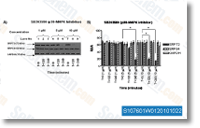
|
|
| S1077 | SB202190 | SB202190 is a potent p38 MAPK inhibitor targeting p38α/β with IC50 of 50 nM/100 nM in cell-free assays, sometimes used instead of SB 203580 to investigate potential roles for SAPK2a/p38 in vivo. SB202190 inhibits endothelial cell apoptosis via induction of autophagy and heme oxygenase-1. SB202190 significantly suppresses Erastin‐dependent ferroptosis. |
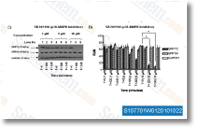
|
|
| S1574 | Doramapimod (BIRB 796) | Doramapimod (BIRB 796) is a pan-p38 MAPK inhibitor with IC50 of 38 nM, 65 nM, 200 nM and 520 nM for p38α/β/γ/δ in cell-free assays, and binds p38α with Kd of 0.1 nM in THP-1 cells, 330-fold greater selectivity versus JNK2, weak inhibition for c-RAF, Fyn and Lck, insignificant inhibition of ERK-1, SYK, IKK2. |
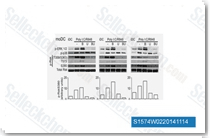
|
|
| S1950 | Metformin HCl | Metformin HCl (1,1-Dimethylbiguanide HCl) decreases hyperglycemia in hepatocytes primarily by suppressing glucose production by the liver (hepatic gluconeogenesis). Metformin promotes mitophagy in mononuclear cells. Metformin induces apoptosis of lung cancer cells through activating JNK/p38 MAPK pathway and GADD153. |
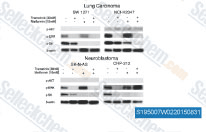
|
|
| S1494 | Ralimetinib (LY2228820) dimesylate | Ralimetinib (LY2228820) dimesylate is a novel and potent inhibitor of p38 MAPK with IC50 of 7 nM in a cell-free assay, does not alter p38 MAPK activation. Phase 1/2. |
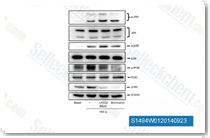
|
|
| S2726 | PH-797804 | PH-797804 is a novel pyridinone inhibitor of p38α with IC50 of 26 nM in a cell-free assay; 4-fold more selective versus p38β and does not inhibit JNK2. Phase 2. |
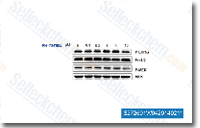
|
|
| S6005 | VX-702 | VX-702 is a highly selective inhibitor of p38α MAPK, 14-fold higher potency against the p38α versus p38β. |
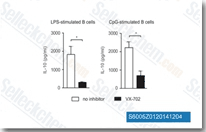
|
|
| S5958 | Metformin | Metformin (1,1-Dimethylbiguanide), a widely used drug for treatment of type 2 diabetes, activates AMP-activated protein kinase (AMPK) in hepatocytes. Metformin promotes mitophagy in mononuclear cells. Metformin induces apoptosis of lung cancer cells through activating JNK/p38 MAPK pathway and GADD153. | ||
| S7686 | ML141 | ML141 (CID-2950007) is demonstrated to be a potent, selective and reversible non-competitive inhibitor of Cdc42 GTPase suitable for in vitro assays, with IC50 of 200 nM and selectivity against other members of the Rho family of GTPases (Rac1, Rab2, Rab7). ML141 is associated with an increase in p38 activation and may induce p38-dependent apoptosis/senescence. ML141 also protects neuroblastoma cells from metformin-induced apoptosis. |
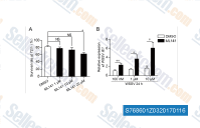
|
|
| S7215 | Losmapimod | Losmapimod is a selective, potent, and orally active p38 MAPK inhibitor with pKi of 8.1 and 7.6 for p38α and p38β, respectively. P38 MAPKs are involved in cell differentiation, apoptosis and autophagy. Phase 3. |
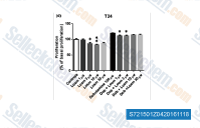
|
|
| S7741 | SB239063 | SB239063 is a potent and selective p38 MAPKα/β inhibitor with IC50 of 44 nM, showing no activity against the γ- and δ-kinase isoforms. |

|
|
| S1458 | Neflamapimod (VX-745) | Neflamapimod (VX-745) is a potent and selective inhibitor of p38α with IC50 of 10 nM, 22-fold greater selectivity versus p38β and no inhibition to p38γ. |
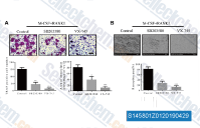
|
|
| S8124 | BMS-582949 | BMS-582949 (PS540446) is a potent and selective p38 mitogen-activated protein kinase (p38 MAPK) inhibitor with IC50 of 13nM,inhibiting both p38 kinase activity and activation of p38. | ||
| S7214 | Skepinone-L | Skepinone-L (CBS3830) is a selective p38α-MAPK inhibitor with IC50 of 5 nM. |
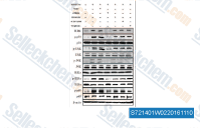
|
|
| S2266 | Asiatic Acid | Asiatic acid (Dammarolic acid, Asiantic acid) is the aglycone of asiaticoside isolated from the plant Centella asiatica, commonly used in wound healing. | ||
| S2928 | TAK-715 | TAK-715 is a p38 MAPK inhibitor for p38α with IC50 of 7.1 nM, 28-fold more selective for p38α over p38β, no inhibition to p38γ/δ, JNK1, ERK1, IKKβ, MEKK1 or TAK1. Phase 2. | ||
| S8125 | Pamapimod | Pamapimod (R-1503, Ro4402257) is a novel, selective inhibitor of p38 mitogen-activated protein kinase. It inhibits p38α and p38β enzymatic activity with IC50 values of 0.014±0.002 and 0.48± 0.04 microM, respectively with no activity against p38delta or p38gamma isoforms. | ||
| S7799 | Pexmetinib | Pexmetinib is a potent, orally bioavailable, dual p38 MAPK/Tie-2 inhibitor with IC50 of 4 nM/18 nM in a HEK-293 cell line. Phase 1. | ||
| S5967 | Berberine chloride hydrate | Berberine (Natural Yellow 18) chloride hydrate is a quaternary ammonium salt from the group of isoquinoline alkaloids. Berberine activates caspase 3 and caspase 8, cleavage of poly ADP-ribose polymerase (PARP) and the release of cytochrome c. Berberine chloride decreases the expression of c-IAP1, Bcl-2 and Bcl-XL. Berberine chloride induces apoptosis with sustained phosphorylation of JNK and p38 MAPK, as well as generation of the ROS. Berberine chloride is a dual topoisomerase I and II inhibitor. Berberine chloride is also a potential autophagy modulator. | ||
| S6502 | SD 0006 | SD0006 is an inhibitor of p38 kinase-alpha (p38alpha) with IC50 values of 0.016 μM and 0.677 μM for p38α and p38β. It is selective for p38α kinase over 50 other kinases screened (including p38γ and p38δ with modest selectivity over p38β). | ||
| S0542 | R1487 | R1487 is an orally bioavailable and highly selective inhibitor of p38α with an ic50 value of 10 nM. | ||
| S8706 | UM-164 | UM-164 is a highly potent, dual c-Src/p38inhibitor of c-Src with a binding constant Kd of 2.7 nM for c-Src and inhibits both p38α and p38β. | ||
| S5183 | PD 169316 | PD 169316 is a potent, selective and cell-permeable p38 MAP kinase inhibitor with IC50 of 89 nM. PD169316 abrogates signaling initiated by both TGFbeta and Activin A. PD169316 shows antiviral activity against Enterovirus71. | ||
| F0171New | p38 MAPK Antibody [N23C2] | Mitogen-activated protein kinase 14, MAP kinase 14; MAPK 14, Cytokine suppressive anti-inflammatory drug-binding protein, CSAID-binding protein, CSBP, MAP kinase MXI2, MAX-interacting protein 2,MAP kinase p38 alpha, MAP kinase p38 α, SAPK2a, MAP kinase 12; MAPK 12, ERK-6, ERK6, MAP kinase p38 gamma, MAPK12, SAPK3, MAP kinase 11; MAPK 11, MAP kinase p38 beta, p38b, SAPK2b, p38-2, MAPK11, PRKM11, SAPK2, SAPK2B, CSBP, CSBP1, CSBP2, MXI2, MAP kinase p38 γ,MAP kinase p38 gamma, Stress-activated protein kinase 3, MAP kinase p38 β, MAP kinase p38 beta, p38b | ||
| F1221 | p38α/MAPK14 Antibody [J11A5] | Mitogen-activated protein kinase 14, MAP kinase 14; MAPK 14, Cytokine suppressive anti-inflammatory drug-binding protein, CSAID-binding protein, CSBP MAP kinase MXI2, MAX-interacting protein 2,Mitogen-activated protein kinase p38 alpha, MAP kinase p38 alpha, Mitogen-activated protein kinase p38 α, MAP kinase p38 α, Stress-activated protein kinase 2a, MAP kinase p38 alpha, SAPK2a, CSBP1, CSBP2, MXI2, Mitogen-activated protein kinase 11, Mitogen-activated protein kinase p38 beta, Mitogen-activated protein kinase p38 β, MAP kinase p38 beta, p38b, MAP kinase p38 β, Stress-activated protein kinase 2b, SAPK2b, p38-2, PRKM11, SAPK2, SAPK2B | ||
| F2658New | 14-3-3 (pan) Antibody [N16K10] | 14-3-3 (pan),pan 14-3-3 | ||
| F1265New | SPARC Antibody [F22E17] | |||
| F1367 | p38δ MAPK Antibody [C13H14] | p38 delta/MAPK13,p38δ MAPK | ||
| F1292New | MAPKAPK-3 Antibody [N6J6] | |||
| S3940 | 3'-Hydroxypterostilbene | 3'-Hydroxypterostilbene (3'-HPT) is one of the active constituents of Sphaerophysa salsula and Pterocarpus marsupium which may be useful in treating different types of haematological malignancies. 3'-Hydroxypterostilbene, a natural pterostilbene analogue, effectively inhibits the growth of human colon cancer cells (IC50s of 9.0, 40.2, and 70.9 µM for COLO 205, HCT-116, and HT-29 cells, respectively) by inducing apoptosis and autophagy. 3'-Hydroxypterostilbene inhibits the PI3K/Akt/mTOR/p70S6K, and p38MAPK pathways and activates the ERK1/2, JNK1/2 MAPK pathways. | ||
| S9514 | Rotundic acid | Rotundic acid (Rutundic acid), a natural compound, exhibit cytotoxic activities toward human hepatocellular carcinoma (HepG2), malignant melanoma (A375), SCLC (NCI-H446), breast cancer (MCF-7), and colon cancer (HT-29) cell lines.RA induces cell cycle arrest, DNA damage, and apoptosis by modulating the AKT/mTOR and MAPK pathways. | ||
| E2372 | p38-α MAPK-IN-1 | p38-α MAPK-IN-1 is an inhibitor of p38-α, with IC50 value of 2300 nM in EFC displacement assay, and 5500 nM in HTRF assay. | ||
| E3566 | Largeleaf Gentian Root Extract | Largeleaf Gentian Root Extract is extracted from the root of Gentiana macrophylla, which can modulate the CD147/p38/NF-κB pathway. | ||
| S8989 | Xanthatin | Xanthatin is a sesquiterpene lactone isolated from Xanthium strumarium leaves, which can inhibit the nuclear factor kappa-B (NF-κB), mitogen-activated protein kinase (MAPK) and signal transducer and activator of transcription (STATs) signaling pathways. | ||
| S0752 | AUDA | AUDA (compound 43) is a potent inhibitor of soluble epoxide hydrolase (sEH) with IC50 of 18 nM and 69 nM for the mouse sEH and human sEH, respectively. AUDA has anti-inflammatory activity that reduces the protein expression of MMP-9, IL-1β, TNF-α and TGF-β. AUDA downregulates Smad3 and p38 signaling pathways. | ||
| S4884 | Trans-Zeatin | Trans-Zeatina ((E)-Zeatin) is the member of the plant growth hormone family known as cytokinins, which regulate cell division, development, and nutrient processing. Trans-Zeatin inhibits UVB-induced MMP-1 expression, c-Jun activation and phosphorylation of ERK, JNK and p38 MAP kinases (MAPKs) dose-dependently. | ||
| E3656 | Dichroa febrifuga Extract | Dichroa Febrifuga Extract is extracted from Dichroa Febrifuga, which can Suppress PI3K/AKT and MAPK Signaling Pathways. | ||
| S2271 | Berberine chloride | Berberine chloride is a quaternary ammonium salt from the group of isoquinoline alkaloids. Berberine activates caspase 3 and caspase 8, cleavage of poly ADP-ribose polymerase (PARP) and the release of cytochrome c. Berberine chloride decreases the expression of c-IAP1, Bcl-2 and Bcl-XL. Berberine chloride induces apoptosis with sustained phosphorylation of JNK and p38 MAPK, as well as generation of the ROS. Berberine chloride is a dual topoisomerase I and II inhibitor. Berberine chloride is also a potential autophagy modulator. | ||
| E5786New | SB 202190 hydrochloride | SB 202190 hydrochloride is a selective inhibitor of p38 MAP kinase with IC50 values of 50 nM for p38α and 100 nM for p38β2. It exhibits anti-cancer activity, induces autophagy, and is studied for its role in hippocampus-dependent spatial memory and apoptotic regulation under chronic ischemia. | ||
| E3328 | Suberect spatholobus stem Extract | Suberect spatholobus stem Extract is extracted from Suberect spatholobus stem, which can Inhibiti TGF-β1/p38MAPK signaling pathway and the synthesis of ColⅠ, thereby playing a role in the treatment of liver fibrosis. | ||
| E0114 | Dilmapimod (SB-681323) | Dilmapimod (SB-681323,GW 681323) is a potent p38 MAPK inhibitor that potentially suppresses inflammation in chronic obstructive pulmonary disease. | ||
| S9315 | Praeruptorin A | Praeruptorin A, a naturally existing pyranocumarin, is isolated from the dried root of Peucedanum praeruptorum Dunn. Praeruptorin A inhibits p38/Akt-c-Fos-NFATc1 signaling and PLCγ-independent Ca2+ oscillation. Praeruptorin A can significantly upregulates multidrug resistance-associated protein 2 expression via the constitutive androstane receptor-mediated pathway in vitro, and this should be taken as an herb-drug interaction. | ||
| S6920 | SEA0400 | SEA0400 is a selective and potent inhibitor of the Na+-Ca2+ exchanger (NCX) that inhibits Na+-dependent Ca2+ uptake in cultured neurons, astrocytes, and microglia with IC50 of 33 nM, 5.0 nM and 8.3 nM, respectively. SEA0400 prevents sodium nitroprusside (SNP) from increasing ERK and p38 MAPK phosphorylation and production of reactive oxygen species (ROS) in an extracellular Ca(2+)-dependent manner. | ||
| E3365 | Weigela Grandiflora Fortune Extract | Weigela Grandiflora Fortune Extract is extracted from Weigela Grandiflora Fortune, which decreases the infection-mediated expression of inflammatory mediators by inhibiting the AKT/NF-κB and MAPK signaling pathways. | ||
| E4791New | Adezmapimod hydrochloride | Adezmapimod hydrochloride (RWJ 64809 hydrochloride, SB 203580 hydrochloride) is an inhibitor of the MAPK family member termed as stress-activated protein kinase 2a(SAPK2a; also known as p38). It exhibits IC50 of SAPK2a/p38 and SAPK2b/p38β2 with IC50 values of 50 nM and 500 nM respectively and can be used in research of chronic inflammatory diseases, such as rheumatoid arthritis. | ||
| S0387 | SB 242235 | SB-242235 is a potent and selective p38 MAP kinase inhibitor, inhibits p38 MAP kinase induced by IL-1β with an IC50 of approximately 1.0 μM in primary human chondrocytes. | ||
| S0388 | SD169 | SD-169(5-Carbamoylindole) is a selective inhibitor of p38α MAPK, which can reduce p38 and HSP60 expression in T cells of the pancreatic beta islets. | ||
| E3592 | Panax notoginseng Root Extract | Panax Notoginseng Root Extract is extracted from the root of Panax Notoginseng, which exerts protective effect on metabolic syndrome through MAPK-mediated adipose thermogenic activation. | ||
| E3593 | Panax notoginseng Rhizoma Extract | Panax Notoginseng Rhizoma Extract is extracted from the rhizoma of Panax Notoginseng, which exerts protective effect on metabolic syndrome through MAPK-mediated adipose thermogenic activation. | ||
| S0844 | NDMC101 | NDMC101 inhibits osteoclastogenesis which also ameliorates paw swelling and inflammatory bone destruction, associating with the inhibition of such transcription factors as NF-κB and NFATc1 as well as multiple protein kinases, including p38, ERK, and JNK. | ||
| S9075 | Mulberroside A | Mulberroside A, isolated from the ethanol extract of Morus alba roots, is widely employed as an active ingredient in cosmetic products due to its anti-tyrosinase and anti-oxidant activities. Mulberroside A decreases the expressions of TNF-α, IL-1β and IL-6 and inhibits the activation of NALP3, caspase-1 and NF-κB and the phosphorylation of ERK, JNK and p38. | ||
| S0186 | TA-01 | TA-01 is a potent inhibitor of CK1δ/ε and p38 MAPK with IC50 of 6.4 nM, 6.8 nM and 6.7 nM for CK1ε, CK1δ and p38 MAPK, respectively. | ||
| E0526 | sappanone A | Sappanone A, a homoisoflavanone isolated from the heartwood of Caesalpinia sappan (Leguminosae), induces HO-1 expression by activating Nrf2 through the p38 MAPK pathway, suppresses LPS-induced NF-κB activation by suppressing the phosphorylation of RelA/p65 at Ser536, exerting its anti-inflammatory effect. | ||
| E2399 | Falnidamol | Falnidamol (BIBX1382) is a selective inhibitor of epidermal growth factor receptor (EGFR), exerting anti-cancer role in human head and neck squamous cell carcinomas both in vitro and in vivo through suppressing mitogen-activated protein kinases (MAPKs) signaling. | ||
| E2630 | SKF-86002 | SKF-86002 is an orally active p38 MAPK inhibitor, inhibits lipopolysaccharide (LPS)-stimulate human monocyte IL-1 and TNF-α production with IC50 of 1 μM, also inhibits lipoxygenase- and cyclooxygenase-mediated metabolism of arachidonic acid. | ||
| S3888 | 3,4',5-Trimethoxy-trans-stilbene | 3,4',5-Trimethoxy-trans-stilbene (MR-3) is a methylated derivative of resveratrol and shows more potent inhibitory effects on the growth of human cancer cells (HT-29, PC-3, COLO 205) with IC50 values of 81.31, 42.71 and 6.25 μM, respectively. | ||
| S6347 | 5'-N-Ethylcarboxamidoadenosine (NECA) | 5'-N-Ethylcarboxamidoadenosine (NECA, 5'-(N-Ethylcarboxamido)adenosine, Adenosine-5'N-ethylcarboxamide, 5'-Ethylcarboxamidoadenosine) is a stable, nonselective adenosine receptor agonist. 5'-N-Ethylcarboxamidoadenosine acts via multiple mechanisms including: reducing diabetes-induced oxidative stress, inhibiting gene expression of IL-18, TNF-α and ICAM-1 (intercellular adhesion molecule 1 (CD54)), and blocking activation of the JNK-MAPK pathway. | ||
| E2661 | Chitosan oligosaccharide | Chitosan oligosaccharide (COS) is an oligomer of β-(1➔4)-linked d-glucosamine, of which actions involve the modulation of several important pathways including the suppression of nuclear factor kappa B (NF-κB) and mitogen-activated protein kinases (MAPK) and the activation of AMP-activated protein kinase (AMPK). | ||
| S6807 | TA-02 | TA-02 is a p38 MAPK inhibitor with IC50 of 20 nM. TA-02 especially inhibits TGFBR-2. | ||
| E3786 | Radix Scrophulariae Extract | Radix Scrophulariae Extract is derived from Radix Scrophulariae, which has anti-apoptotic and anti-inflammatory effects, potentially operating by affecting the mitogen-activated protein kinases (MAPKs) signaling pathway and inhibition of the NF-κB pathway. | ||
| E1938New | HRX215 | HRX215 (Darizmetinib) is a first-in-class, highly potent, selective, and orally active inhibitor of MKK4 with an IC50 of 0.02 µM. It enhances liver regeneration, prevents liver failure following extensive hepatectomy in pigs, and has potential to prevent liver failure after major oncological liver resections or transplantation of small liver grafts in humans. | ||
| E3033 | Pulsatillae Extract | Pulsatillae Extract is extracted from Pulsatilla chinensis, major active constituent of which can reduce tumorigenesis, metastasis and immunosuppression of tumor via disruption of the MAPK signaling pathway. | ||
| S1076 | Adezmapimod (SB203580) | Adezmapimod (SB203580, RWJ 64809, PB 203580) is a p38 MAPK inhibitor with IC50 of 0.3-0.5 μM in THP-1 cells, 10-fold less sensitive to SAPK3(106T) and SAPK4(106T) and blocks PKB phosphorylation with IC50 of 3-5 μM. SB203580 induces mitophagy and autophagy. |

|
|
| S1077 | SB202190 | SB202190 is a potent p38 MAPK inhibitor targeting p38α/β with IC50 of 50 nM/100 nM in cell-free assays, sometimes used instead of SB 203580 to investigate potential roles for SAPK2a/p38 in vivo. SB202190 inhibits endothelial cell apoptosis via induction of autophagy and heme oxygenase-1. SB202190 significantly suppresses Erastin‐dependent ferroptosis. |

|
|
| S1574 | Doramapimod (BIRB 796) | Doramapimod (BIRB 796) is a pan-p38 MAPK inhibitor with IC50 of 38 nM, 65 nM, 200 nM and 520 nM for p38α/β/γ/δ in cell-free assays, and binds p38α with Kd of 0.1 nM in THP-1 cells, 330-fold greater selectivity versus JNK2, weak inhibition for c-RAF, Fyn and Lck, insignificant inhibition of ERK-1, SYK, IKK2. |

|
|
| S1494 | Ralimetinib (LY2228820) dimesylate | Ralimetinib (LY2228820) dimesylate is a novel and potent inhibitor of p38 MAPK with IC50 of 7 nM in a cell-free assay, does not alter p38 MAPK activation. Phase 1/2. |

|
|
| S2726 | PH-797804 | PH-797804 is a novel pyridinone inhibitor of p38α with IC50 of 26 nM in a cell-free assay; 4-fold more selective versus p38β and does not inhibit JNK2. Phase 2. |

|
|
| S6005 | VX-702 | VX-702 is a highly selective inhibitor of p38α MAPK, 14-fold higher potency against the p38α versus p38β. |

|
|
| S7215 | Losmapimod | Losmapimod is a selective, potent, and orally active p38 MAPK inhibitor with pKi of 8.1 and 7.6 for p38α and p38β, respectively. P38 MAPKs are involved in cell differentiation, apoptosis and autophagy. Phase 3. |

|
|
| S7741 | SB239063 | SB239063 is a potent and selective p38 MAPKα/β inhibitor with IC50 of 44 nM, showing no activity against the γ- and δ-kinase isoforms. |

|
|
| S1458 | Neflamapimod (VX-745) | Neflamapimod (VX-745) is a potent and selective inhibitor of p38α with IC50 of 10 nM, 22-fold greater selectivity versus p38β and no inhibition to p38γ. |

|
|
| S8124 | BMS-582949 | BMS-582949 (PS540446) is a potent and selective p38 mitogen-activated protein kinase (p38 MAPK) inhibitor with IC50 of 13nM,inhibiting both p38 kinase activity and activation of p38. | ||
| S7214 | Skepinone-L | Skepinone-L (CBS3830) is a selective p38α-MAPK inhibitor with IC50 of 5 nM. |

|
|
| S2928 | TAK-715 | TAK-715 is a p38 MAPK inhibitor for p38α with IC50 of 7.1 nM, 28-fold more selective for p38α over p38β, no inhibition to p38γ/δ, JNK1, ERK1, IKKβ, MEKK1 or TAK1. Phase 2. | ||
| S8125 | Pamapimod | Pamapimod (R-1503, Ro4402257) is a novel, selective inhibitor of p38 mitogen-activated protein kinase. It inhibits p38α and p38β enzymatic activity with IC50 values of 0.014±0.002 and 0.48± 0.04 microM, respectively with no activity against p38delta or p38gamma isoforms. | ||
| S7799 | Pexmetinib | Pexmetinib is a potent, orally bioavailable, dual p38 MAPK/Tie-2 inhibitor with IC50 of 4 nM/18 nM in a HEK-293 cell line. Phase 1. | ||
| S6502 | SD 0006 | SD0006 is an inhibitor of p38 kinase-alpha (p38alpha) with IC50 values of 0.016 μM and 0.677 μM for p38α and p38β. It is selective for p38α kinase over 50 other kinases screened (including p38γ and p38δ with modest selectivity over p38β). | ||
| S0542 | R1487 | R1487 is an orally bioavailable and highly selective inhibitor of p38α with an ic50 value of 10 nM. | ||
| S8706 | UM-164 | UM-164 is a highly potent, dual c-Src/p38inhibitor of c-Src with a binding constant Kd of 2.7 nM for c-Src and inhibits both p38α and p38β. | ||
| S5183 | PD 169316 | PD 169316 is a potent, selective and cell-permeable p38 MAP kinase inhibitor with IC50 of 89 nM. PD169316 abrogates signaling initiated by both TGFbeta and Activin A. PD169316 shows antiviral activity against Enterovirus71. | ||
| S3940 | 3'-Hydroxypterostilbene | 3'-Hydroxypterostilbene (3'-HPT) is one of the active constituents of Sphaerophysa salsula and Pterocarpus marsupium which may be useful in treating different types of haematological malignancies. 3'-Hydroxypterostilbene, a natural pterostilbene analogue, effectively inhibits the growth of human colon cancer cells (IC50s of 9.0, 40.2, and 70.9 µM for COLO 205, HCT-116, and HT-29 cells, respectively) by inducing apoptosis and autophagy. 3'-Hydroxypterostilbene inhibits the PI3K/Akt/mTOR/p70S6K, and p38MAPK pathways and activates the ERK1/2, JNK1/2 MAPK pathways. | ||
| E2372 | p38-α MAPK-IN-1 | p38-α MAPK-IN-1 is an inhibitor of p38-α, with IC50 value of 2300 nM in EFC displacement assay, and 5500 nM in HTRF assay. | ||
| S8989 | Xanthatin | Xanthatin is a sesquiterpene lactone isolated from Xanthium strumarium leaves, which can inhibit the nuclear factor kappa-B (NF-κB), mitogen-activated protein kinase (MAPK) and signal transducer and activator of transcription (STATs) signaling pathways. | ||
| S0752 | AUDA | AUDA (compound 43) is a potent inhibitor of soluble epoxide hydrolase (sEH) with IC50 of 18 nM and 69 nM for the mouse sEH and human sEH, respectively. AUDA has anti-inflammatory activity that reduces the protein expression of MMP-9, IL-1β, TNF-α and TGF-β. AUDA downregulates Smad3 and p38 signaling pathways. | ||
| S4884 | Trans-Zeatin | Trans-Zeatina ((E)-Zeatin) is the member of the plant growth hormone family known as cytokinins, which regulate cell division, development, and nutrient processing. Trans-Zeatin inhibits UVB-induced MMP-1 expression, c-Jun activation and phosphorylation of ERK, JNK and p38 MAP kinases (MAPKs) dose-dependently. | ||
| E3656 | Dichroa febrifuga Extract | Dichroa Febrifuga Extract is extracted from Dichroa Febrifuga, which can Suppress PI3K/AKT and MAPK Signaling Pathways. | ||
| E5786New | SB 202190 hydrochloride | SB 202190 hydrochloride is a selective inhibitor of p38 MAP kinase with IC50 values of 50 nM for p38α and 100 nM for p38β2. It exhibits anti-cancer activity, induces autophagy, and is studied for its role in hippocampus-dependent spatial memory and apoptotic regulation under chronic ischemia. | ||
| E3328 | Suberect spatholobus stem Extract | Suberect spatholobus stem Extract is extracted from Suberect spatholobus stem, which can Inhibiti TGF-β1/p38MAPK signaling pathway and the synthesis of ColⅠ, thereby playing a role in the treatment of liver fibrosis. | ||
| E0114 | Dilmapimod (SB-681323) | Dilmapimod (SB-681323,GW 681323) is a potent p38 MAPK inhibitor that potentially suppresses inflammation in chronic obstructive pulmonary disease. | ||
| S9315 | Praeruptorin A | Praeruptorin A, a naturally existing pyranocumarin, is isolated from the dried root of Peucedanum praeruptorum Dunn. Praeruptorin A inhibits p38/Akt-c-Fos-NFATc1 signaling and PLCγ-independent Ca2+ oscillation. Praeruptorin A can significantly upregulates multidrug resistance-associated protein 2 expression via the constitutive androstane receptor-mediated pathway in vitro, and this should be taken as an herb-drug interaction. | ||
| S6920 | SEA0400 | SEA0400 is a selective and potent inhibitor of the Na+-Ca2+ exchanger (NCX) that inhibits Na+-dependent Ca2+ uptake in cultured neurons, astrocytes, and microglia with IC50 of 33 nM, 5.0 nM and 8.3 nM, respectively. SEA0400 prevents sodium nitroprusside (SNP) from increasing ERK and p38 MAPK phosphorylation and production of reactive oxygen species (ROS) in an extracellular Ca(2+)-dependent manner. | ||
| E3365 | Weigela Grandiflora Fortune Extract | Weigela Grandiflora Fortune Extract is extracted from Weigela Grandiflora Fortune, which decreases the infection-mediated expression of inflammatory mediators by inhibiting the AKT/NF-κB and MAPK signaling pathways. | ||
| E4791New | Adezmapimod hydrochloride | Adezmapimod hydrochloride (RWJ 64809 hydrochloride, SB 203580 hydrochloride) is an inhibitor of the MAPK family member termed as stress-activated protein kinase 2a(SAPK2a; also known as p38). It exhibits IC50 of SAPK2a/p38 and SAPK2b/p38β2 with IC50 values of 50 nM and 500 nM respectively and can be used in research of chronic inflammatory diseases, such as rheumatoid arthritis. | ||
| S0387 | SB 242235 | SB-242235 is a potent and selective p38 MAP kinase inhibitor, inhibits p38 MAP kinase induced by IL-1β with an IC50 of approximately 1.0 μM in primary human chondrocytes. | ||
| S0388 | SD169 | SD-169(5-Carbamoylindole) is a selective inhibitor of p38α MAPK, which can reduce p38 and HSP60 expression in T cells of the pancreatic beta islets. | ||
| S9075 | Mulberroside A | Mulberroside A, isolated from the ethanol extract of Morus alba roots, is widely employed as an active ingredient in cosmetic products due to its anti-tyrosinase and anti-oxidant activities. Mulberroside A decreases the expressions of TNF-α, IL-1β and IL-6 and inhibits the activation of NALP3, caspase-1 and NF-κB and the phosphorylation of ERK, JNK and p38. | ||
| S0186 | TA-01 | TA-01 is a potent inhibitor of CK1δ/ε and p38 MAPK with IC50 of 6.4 nM, 6.8 nM and 6.7 nM for CK1ε, CK1δ and p38 MAPK, respectively. | ||
| E2399 | Falnidamol | Falnidamol (BIBX1382) is a selective inhibitor of epidermal growth factor receptor (EGFR), exerting anti-cancer role in human head and neck squamous cell carcinomas both in vitro and in vivo through suppressing mitogen-activated protein kinases (MAPKs) signaling. | ||
| E2630 | SKF-86002 | SKF-86002 is an orally active p38 MAPK inhibitor, inhibits lipopolysaccharide (LPS)-stimulate human monocyte IL-1 and TNF-α production with IC50 of 1 μM, also inhibits lipoxygenase- and cyclooxygenase-mediated metabolism of arachidonic acid. | ||
| S3888 | 3,4',5-Trimethoxy-trans-stilbene | 3,4',5-Trimethoxy-trans-stilbene (MR-3) is a methylated derivative of resveratrol and shows more potent inhibitory effects on the growth of human cancer cells (HT-29, PC-3, COLO 205) with IC50 values of 81.31, 42.71 and 6.25 μM, respectively. | ||
| S6347 | 5'-N-Ethylcarboxamidoadenosine (NECA) | 5'-N-Ethylcarboxamidoadenosine (NECA, 5'-(N-Ethylcarboxamido)adenosine, Adenosine-5'N-ethylcarboxamide, 5'-Ethylcarboxamidoadenosine) is a stable, nonselective adenosine receptor agonist. 5'-N-Ethylcarboxamidoadenosine acts via multiple mechanisms including: reducing diabetes-induced oxidative stress, inhibiting gene expression of IL-18, TNF-α and ICAM-1 (intercellular adhesion molecule 1 (CD54)), and blocking activation of the JNK-MAPK pathway. | ||
| E2661 | Chitosan oligosaccharide | Chitosan oligosaccharide (COS) is an oligomer of β-(1➔4)-linked d-glucosamine, of which actions involve the modulation of several important pathways including the suppression of nuclear factor kappa B (NF-κB) and mitogen-activated protein kinases (MAPK) and the activation of AMP-activated protein kinase (AMPK). | ||
| S6807 | TA-02 | TA-02 is a p38 MAPK inhibitor with IC50 of 20 nM. TA-02 especially inhibits TGFBR-2. | ||
| E1938New | HRX215 | HRX215 (Darizmetinib) is a first-in-class, highly potent, selective, and orally active inhibitor of MKK4 with an IC50 of 0.02 µM. It enhances liver regeneration, prevents liver failure following extensive hepatectomy in pigs, and has potential to prevent liver failure after major oncological liver resections or transplantation of small liver grafts in humans. | ||
| E3033 | Pulsatillae Extract | Pulsatillae Extract is extracted from Pulsatilla chinensis, major active constituent of which can reduce tumorigenesis, metastasis and immunosuppression of tumor via disruption of the MAPK signaling pathway. | ||
| S1950 | Metformin HCl | Metformin HCl (1,1-Dimethylbiguanide HCl) decreases hyperglycemia in hepatocytes primarily by suppressing glucose production by the liver (hepatic gluconeogenesis). Metformin promotes mitophagy in mononuclear cells. Metformin induces apoptosis of lung cancer cells through activating JNK/p38 MAPK pathway and GADD153. |

|
|
| S5958 | Metformin | Metformin (1,1-Dimethylbiguanide), a widely used drug for treatment of type 2 diabetes, activates AMP-activated protein kinase (AMPK) in hepatocytes. Metformin promotes mitophagy in mononuclear cells. Metformin induces apoptosis of lung cancer cells through activating JNK/p38 MAPK pathway and GADD153. | ||
| S7686 | ML141 | ML141 (CID-2950007) is demonstrated to be a potent, selective and reversible non-competitive inhibitor of Cdc42 GTPase suitable for in vitro assays, with IC50 of 200 nM and selectivity against other members of the Rho family of GTPases (Rac1, Rab2, Rab7). ML141 is associated with an increase in p38 activation and may induce p38-dependent apoptosis/senescence. ML141 also protects neuroblastoma cells from metformin-induced apoptosis. |

|
|
| S2266 | Asiatic Acid | Asiatic acid (Dammarolic acid, Asiantic acid) is the aglycone of asiaticoside isolated from the plant Centella asiatica, commonly used in wound healing. | ||
| S5967 | Berberine chloride hydrate | Berberine (Natural Yellow 18) chloride hydrate is a quaternary ammonium salt from the group of isoquinoline alkaloids. Berberine activates caspase 3 and caspase 8, cleavage of poly ADP-ribose polymerase (PARP) and the release of cytochrome c. Berberine chloride decreases the expression of c-IAP1, Bcl-2 and Bcl-XL. Berberine chloride induces apoptosis with sustained phosphorylation of JNK and p38 MAPK, as well as generation of the ROS. Berberine chloride is a dual topoisomerase I and II inhibitor. Berberine chloride is also a potential autophagy modulator. | ||
| S2271 | Berberine chloride | Berberine chloride is a quaternary ammonium salt from the group of isoquinoline alkaloids. Berberine activates caspase 3 and caspase 8, cleavage of poly ADP-ribose polymerase (PARP) and the release of cytochrome c. Berberine chloride decreases the expression of c-IAP1, Bcl-2 and Bcl-XL. Berberine chloride induces apoptosis with sustained phosphorylation of JNK and p38 MAPK, as well as generation of the ROS. Berberine chloride is a dual topoisomerase I and II inhibitor. Berberine chloride is also a potential autophagy modulator. | ||
| E0526 | sappanone A | Sappanone A, a homoisoflavanone isolated from the heartwood of Caesalpinia sappan (Leguminosae), induces HO-1 expression by activating Nrf2 through the p38 MAPK pathway, suppresses LPS-induced NF-κB activation by suppressing the phosphorylation of RelA/p65 at Ser536, exerting its anti-inflammatory effect. | ||
| S9514 | Rotundic acid | Rotundic acid (Rutundic acid), a natural compound, exhibit cytotoxic activities toward human hepatocellular carcinoma (HepG2), malignant melanoma (A375), SCLC (NCI-H446), breast cancer (MCF-7), and colon cancer (HT-29) cell lines.RA induces cell cycle arrest, DNA damage, and apoptosis by modulating the AKT/mTOR and MAPK pathways. | ||
| E3566 | Largeleaf Gentian Root Extract | Largeleaf Gentian Root Extract is extracted from the root of Gentiana macrophylla, which can modulate the CD147/p38/NF-κB pathway. | ||
| F0171New | p38 MAPK Antibody [N23C2] | Mitogen-activated protein kinase 14, MAP kinase 14; MAPK 14, Cytokine suppressive anti-inflammatory drug-binding protein, CSAID-binding protein, CSBP, MAP kinase MXI2, MAX-interacting protein 2,MAP kinase p38 alpha, MAP kinase p38 α, SAPK2a, MAP kinase 12; MAPK 12, ERK-6, ERK6, MAP kinase p38 gamma, MAPK12, SAPK3, MAP kinase 11; MAPK 11, MAP kinase p38 beta, p38b, SAPK2b, p38-2, MAPK11, PRKM11, SAPK2, SAPK2B, CSBP, CSBP1, CSBP2, MXI2, MAP kinase p38 γ,MAP kinase p38 gamma, Stress-activated protein kinase 3, MAP kinase p38 β, MAP kinase p38 beta, p38b | ||
| F2658New | 14-3-3 (pan) Antibody [N16K10] | 14-3-3 (pan),pan 14-3-3 | ||
| F1265New | SPARC Antibody [F22E17] | |||
| F1292New | MAPKAPK-3 Antibody [N6J6] | |||
| E5786New | SB 202190 hydrochloride | SB 202190 hydrochloride is a selective inhibitor of p38 MAP kinase with IC50 values of 50 nM for p38α and 100 nM for p38β2. It exhibits anti-cancer activity, induces autophagy, and is studied for its role in hippocampus-dependent spatial memory and apoptotic regulation under chronic ischemia. | ||
| E4791New | Adezmapimod hydrochloride | Adezmapimod hydrochloride (RWJ 64809 hydrochloride, SB 203580 hydrochloride) is an inhibitor of the MAPK family member termed as stress-activated protein kinase 2a(SAPK2a; also known as p38). It exhibits IC50 of SAPK2a/p38 and SAPK2b/p38β2 with IC50 values of 50 nM and 500 nM respectively and can be used in research of chronic inflammatory diseases, such as rheumatoid arthritis. | ||
| E1938New | HRX215 | HRX215 (Darizmetinib) is a first-in-class, highly potent, selective, and orally active inhibitor of MKK4 with an IC50 of 0.02 µM. It enhances liver regeneration, prevents liver failure following extensive hepatectomy in pigs, and has potential to prevent liver failure after major oncological liver resections or transplantation of small liver grafts in humans. |







































